
Sterling silver vintage walking cane (London 1914) - 90cm
Vintage walking cane, sterling silver hallmarked collar (London 1914). Length 90 cm

Horn & Ebony Walking Cane with Gilded Silver Decoration
Antique horn & ebony walking cane, horn handle, with gilded silver decoration (monogrammed), on ebony shaft. Length 90 cm
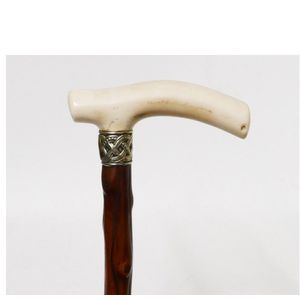
Hazelnut Cane with Ivory Handle and Silver Collar
A 19th century hazelnut walking cane, the shaft terminating in an ivory handle with a decorative silver plate collar.

Silver Rose Walking Stick
A 19th century malacca walking stick, the curved handle of silver decorated with roses and stamped 80 cm

Silver Parrot Head Walking Stick
A 19th century walking stick, the wooden shaft with curved handle terminating in a silver parrots head decorated with oak leaves, a woven silver wire band to the shaft.

19th Century Silver-Mounted Walking Sticks
Six walking sticks, some with silver mounts, 19th century

Horn Horse Walking Stick with Glass Eyes
Wonderful walking stick, the handle carved in horn in the form of a horse, set with glass eyes, above silver mount and tapering support, length 89 cm

George V Silver & Horn Walking Stick, 1921
George V sterling silver and horn walking stick, set with a curved horn handle and silver mount, hallmarked Chester, 1921, with tapering support, length 80.5 cm

Sterling Silver Accented Edwardian Walking Stick
Edwardian walking stick, in the natural form of the wood, accented with sterling silver mount, hallmarked, Birmingham, 1911, length 92 cm

Engraved Prunus Branches Silver Walking Stick
20th century silver knop handle walking stick, the handle decorated with engraved prunus branches, above a tapering support, length 90 cm
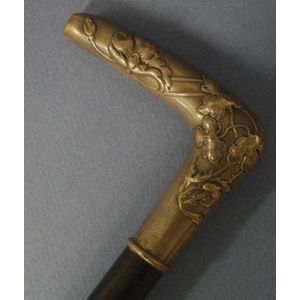
Art Nouveau Sterling Silver Walking Stick - 81cm
Sterling silver Art Nouveau cane walking stick, length 81 cm

Russian Silver and Ebony Walking Stick with Gold Emblems
Russian silver and ebony walking stick, (84 zolotnik 875/1000 purity), with 5 silver and 4 yellow gold emblems attached to the rod, circa 1908 - 1926, 90 cm long approx

Art Deco Glass & Silver Walking Stick, London 1927
Art Deco walking stick, in twisted glass & wood with silver mount, marked London, 1927, approx 94 cm high

Embossed Sterling Silver Walking Stick Handle
Sterling silver walking stick/parasol handle with embossed decoration

Silver-Topped Malacca Walking Cane - 89cm Long
Silver topped Malacca walking cane, 89 cm long approx.

Sterling silver walking stick with whale tooth handle
English sterling silver and whales tooth handle walking stick
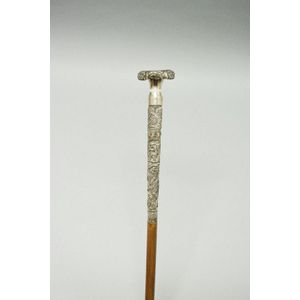
Silver-Mounted SE Asian Walking Stick - 94cm
South East Asian silver mounted walking stick, approx 94 cmlong

Sterling Banded Horn Walking Stick by George Adams Tattersalls
Horn handled walking stick with sterling band engraved George Adams Tattersalls

Coromandel Walking Stick with Silver Top
Early 19th coromandel walking stick. Hallmarked silver top, marks worn. Old repair to stick. Length 91 cm
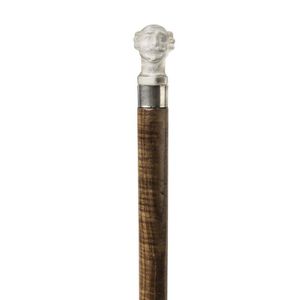
Rare Australian Fiddleback Blackwood Walking Stick with Glass Handle
A rare Australian fiddleback blackwood walking stick with glass bust handle and sterling silver collar, 19th century

19th Century Asian Silver Topped Walking Cane
An Asian silver topped walking cane, 19th century, 89 cm
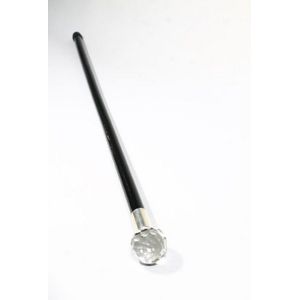
Crystal-handled silver mounted walking cane, c. 1930
A gent's facet-cut crystal handled walking cane/stick, with sterling silver mount on an ebonised shaft, c. 1930, height 87.5 cm
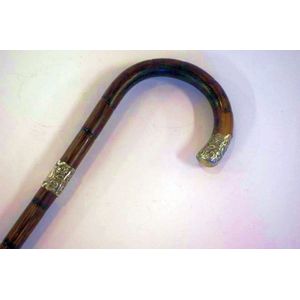
Edwardian Sterling Silver Walking Stick, London 1906
Edwardian sterling silver mounted walking stick, hallmarked London 1906, 91 cm long

Ebony Walking Stick with Silver Top (8 words)
Walking stick, late 19th century, carved ebony, with silver top, hallmarked Birmingham 1894, length 82 cm
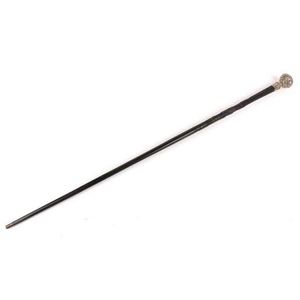
Irish Bog Oak Walking Stick with Silver Top
Walking stick, late 19th century, Irish carved bog oak, with silver top, length 91 cm

Ebony Walking Stick with Silver Top
Walking stick, late 19th century, ebony with silver top, hallmarked London, length 87 cm

Antique Silver Mounted Walking Cane, Stamped 'FB'
Rare C1900 silver mounted walking cane, stamped 'FB', 93 cm long

Birmingham Antique Silver Walking Stick, 1891
Antique silver topped walking stick marked Birmingham, 1891 92 cm long

1893 London Hallmarked Silver and Ivory Walking Cane
Sterling silver and ivory handled walking cane, hallmarked London 1893, 91 cm long.

Late 19th Century Silver Mounted Fiddleback Blackwood Walking Stick
A silver mounted fiddleback blackwood walking stick, late 19th century, 86.5 cm

Silver mounted walking stick, German/Austrian, early 20th century
A fine silver mounted walking stick, German or Austrian, early 20th century, 88 cm
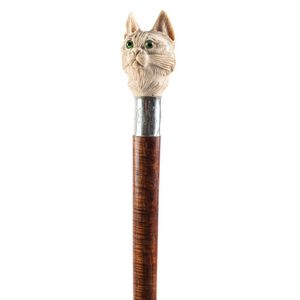
19th Century Fiddleback Blackwood Walking Stick with Cat Handle
A fiddleback blackwood walking stick, 19th century, with carved cats head handle, glass eyes and silver collar, 96 cm
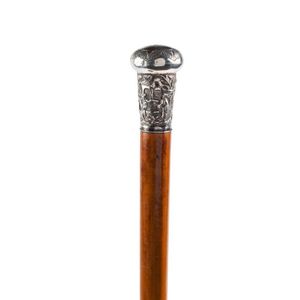
Late 19th Century Cantonese Silver Walking Cane
A Cantonese silver mounted walking cane, late 19th century, 92.5 cm

Fiddleback Blackwood Walking Stick with Silver Magnifying Top
A rare fiddleback blackwood walking stick with sterling silver compartment top revealing a magnifying glass, 19th century

Late 19th Century Silver Mounted Walking Cane
A silver mounted walking cane, late 19th century, 83 cm
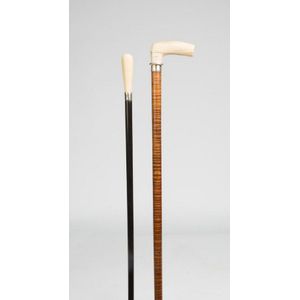
19th Century Silver and Ebony Walking Sticks
Two silver mounted fiddleback and ebony walking sticks, 19th century, 90 cm and 92 cm
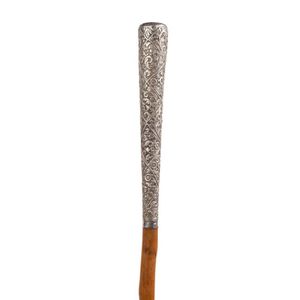
19th Century Silver-Mounted Carved Beech Walking Cane
A silver mounted carved English beech walking cane, 19th century, 92.5 cm

Antique Sterling Silver Walking Stick with Horn Handle
Early hallmarked sterling silver collared walking stick. Chester mark rubbed. Maker Fo' horn handle.

Vintage Sterling Silver Walking Stick - 80cm Length
Vintage sterling silver top walking stick, 80 cm long

Victorian Silver and Ivory Walking Stick with Provenance
A late Victorian silver, ivory and malacca cane walking stick, the approximate T-form ivory handle with decorative embossed silver cap ends and fitting to the tapered malacca shaft, engraved 'W.S.' reputedly a presentation upon the achievement of becoming…
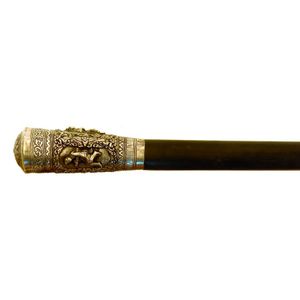
Indian Presentation Walking Stick with Ebony and Silver Handle
A large and impressive ebony and silver handled Indian presentation walking stick, the tapered handle with repousse traditional figures within scrolling cartouches, presentation inscribed 'Col. Eliott' (Colonel Eliott), the long wide tapered shaft of good…

Hermes Leather Riding Crop with Silver Ferrule, 1982
An Hermes of Paris leather riding crop, 1982 London, with maker's mark for Ra (silver ferrule), the fine plaited leather crop with punched and tooled detailing to the handle, with a sterling silver ferrule and an HermEs Paris stud to knop. Length 75 cm

Sterling Silver Knarled Wood Walking Stick
Antique Malacca walking stick with a sterling silver handle in the form of knarled wood, brass ferrule to bottom. Marked Birmingham, sterling, N' 80 cm high
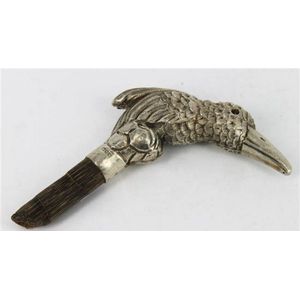
Edwardian Silver Bird Walking Stick Handle, London 1912 (A/F)
An Edwardian silver walking stick handle, in the form of a bird, filagree feathers; London, 1912. A/f.

Sterling Silver Malacca Cane by Crown Jewellery Co
Sterling silver malacca cane, crown Jewellery Co for Walker and Hall

44th Battalion WA Rifles Silver Topped Walking Stick
A 44th Battalion, West Australian Rifles, silver topped walking stick, length 92 cm

Antique Ivory Cane with Engraved Silver Cap
Old Ivory cane with brass ferule and silver cap with early hand engraved initials. The cap has possibly been lacquered and there is some minor repairs to cane, approx 90 cm long
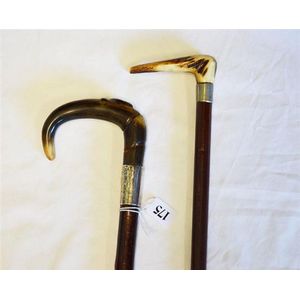
Antique Walking Sticks: Bone and Silver, Chester 1917
Two walking sticks, one with a bone handle (88 cm), one with a silver band, Chester, 1917 (88 cm).

Continental Silver Handled Walking Stick by C.G. Hallberg
Vintage continental silver handled walking stick, by C.G. Hallberg

English Hallmarked Silver Walking Sticks
Antique walking sticks with English hallmarked silver furnishings (3)

Silver Topped Walking Cane with Engraved Details
A gentleman's walking cane with silver repousse top, engraved to the top 'D.A Rang Wala', with buckle band on shaft engraved 'ADE' in script. Silver is unmarked. Height 88 cm
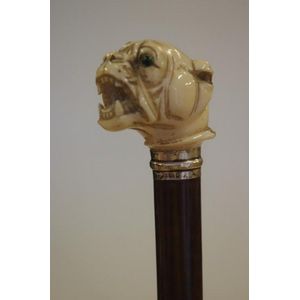
Sterling Silver Collared Snakewood Walking Cane, 1924 London Hallmark
Snakewood & carved ivory walking cane with sterling silver collar hallmarked London 1924, 90.5 cm long

Cherrywood & Sterling Silver Walking Stick - Antique (93cm)
Antique cherrywood & sterling silver walking stick, length 93 cm approx.

Antique Sterling Silver & Vintage Walking Sticks
Antique sterling silver and cane walking stick, hallmarked Birmingham 1902, together with two other vintage cane walking sticks

Carved Dog Head Walking Stick with Silver Mount
Vintage carved dogs head walking stick, with silver mount, L91 cm approx

1905 Hallmarked Sterling Silver Walking Stick
Edwardian hallmarked sterling silver mounted walking stick, hallmarked 1905. Length 77 cm

Hallmarked Sterling Silver Topped Walking Cane, London 1919
English hallmarked sterling silver topped hard wood walking cane London, 1919, maker Wf. Condition good to fair, wear to the handle, loss to the base. Length 91 cm
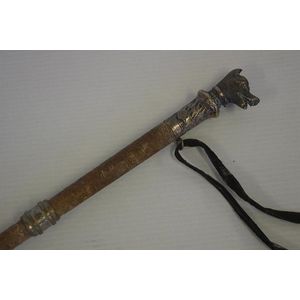
Silver Plated Dog Handle Riding Crop - Antique Zair London
Antique Zair (London) riding crop with silver plated dog shaped handle, 48 cm long approx
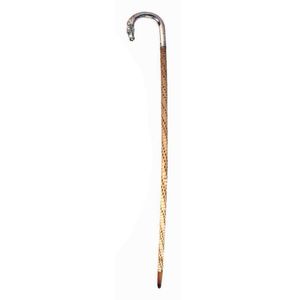
Shark Vertebrae Walking Stick with Horse Head Handle
A vintage walking stick, the shaft comprising of shark vertebrae, the silver plate handle in the form of a horse?s head, horn and brass ferrell to base. Length 35 cm

Art Nouveau Silver Mermaid Walking Cane
A German Art Nouveau silver mounted Guiana Snakewood walking cane, circa 1900, the 800 silver handle depicting a recumbent mermaid supported by waves, the tapered shaft with silver ferrule, probably made in Schwabisch Germany, approximate weight of handle…
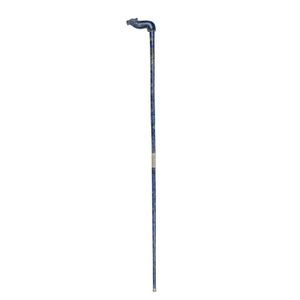
Mogul Indian Lapis Lazuli Walking Cane, 19th Century
A fine lapis lazuli walking cane with silver collar, most likely Mogul Indian, 19th century. 77 cm high

Antique Ebony Walking Stick with Silver Collar, 1913
Ebony walking stick with horn handle and engraved sterling silver collar hallmarked London 1913, 91 cm long

Whale Tooth Walking Stick with Silver Mounts
A Sessionist style whale tooth handled walking stick early 20th century ebonised wood stand with hand beaten sterling silver mounts, possibly Austro-Hungarian, 72 cm high (crack to tooth)

Antique Narwhal Tusk & Silver Walking Cane
An antique Narwhal tusk and silver walking cane, later 19th century, the cane of traditional tapering form and brass capped to the base, a turban style handle in possibly walrus ivory, the sterling silver collar with inscription dated 1883. Length 85 cm

Silver Topped Walking Cane with Concealed Parasol
Walking stick: unusual 19th century silver topped walking cane with a seperate concealed parasol under the cap. 90 cm

Sterling Silver Handle Antique Walking Stick
Antique horn and silver handle walking stick stamped sterling silver
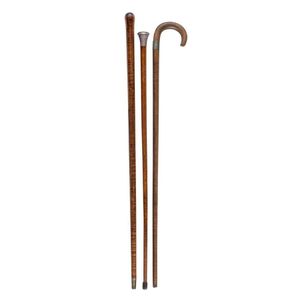
Silver Mounted Blackwood Walking Canes from Australia
Three silver mounted blackwood walking canes, Australia, 19th/20th century, the tallest 89 cm

1939 London Hallmarked Vintage Silver Walking Stick
Vintage walking stick with sterling silver collar hallmarked London 1939

Silver Mounted Carved Sheoak Walking Stick by J.W.D
A rare West Australian silver mounted carved casuarina wood (Sheoak) walking stick, by Joseph Dunkerton, working Fremantle c.1910. Both silver collars signed 'J.W.D.' with silver marks. Length 85.5 cm

Embossed Silver and Malacca Walking Cane, 19th Century
An embossed silver and Malacca walking cane, English, 19th century. 89 cm long.
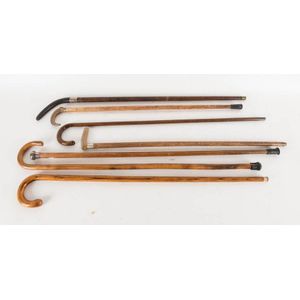
Antique and Vintage Walking Sticks Collection
Walking sticks: group of 7 antique & vintage sticks including silver top & collars, blackwood, etc.

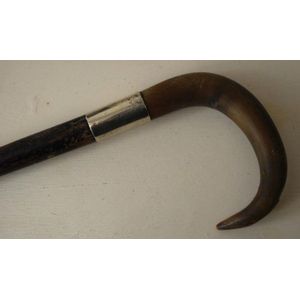


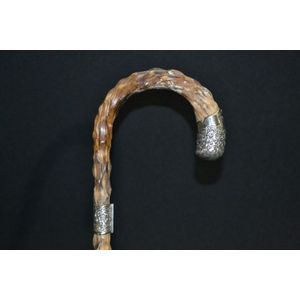

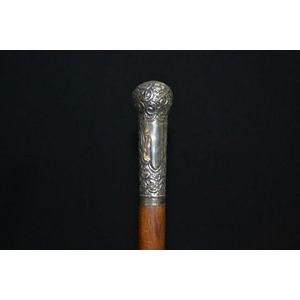














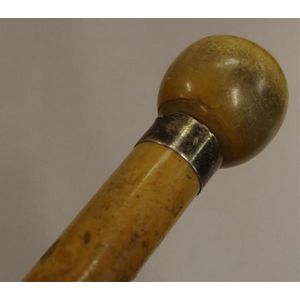



 Loading more...
Loading more...